Los Angeles, California, Hgh State Clinic, Hgh Injections, Hrt Doctors
Los Angeles, California Blood Testing Facilities
 Represents a LabCorp blood testing facility
Represents a LabCorp blood testing facility Represents a Quest Diagnostics blood testing facility
Represents a Quest Diagnostics blood testing facility

Nearby Labcorp Blood Testing facilities:
- Labcorp Center Distance: 1 m, 1825 Cesar Chavez Ave, Los Angeles, Los Angeles County, CA, 90033
- Labcorp Center Distance: 5 m, 1510 S Central Ave. Ste 520, Glendale, Los Angeles County, CA, 91204
- Labcorp Center Distance: 7 m, 50 Alessandro Pl. Suite A10, Pasadena, Los Angeles County, CA, 91105
- Labcorp Center Distance: 8 m, 330 W. Las Tunas Dr. Ste 2, San Gabriel, Los Angeles County, CA, 91776
- Labcorp Center Distance: 9 m, 501 E Hardy St. Suite 150, Inglewood, Los Angeles County, CA, 90301
- Labcorp Center Distance: 10 m, 8540 S Sepulveda Blvd Ste 107, Westchester, Los Angeles County, CA, 90045
- Labcorp Center Distance: 11 m, 10921 Wilshire Blve. Suite 701, Los Angeles, Los Angeles County, CA, 90024
- Labcorp Center Distance: 12 m, 301 W. Huntington Dr. Ste 404, Arcadia, Los Angeles County, CA, 91007
- Labcorp Center Distance: 14 m, 1821 Wilshire Blvd. Ste 210, Santa Monica, Los Angeles County, CA, 90403
- Labcorp Center Distance: 16 m, 1135 S. Sunset Ave. Ste 403, West Covina, Los Angeles County, CA, 91790
- Labcorp Center Distance: 17 m, 3500 Lomita Blvd. Suite 102, Torrance, Los Angeles County, CA, 90505
- Labcorp Center Distance: 18 m, 18399 Ventura Blvd. Suite 17, Tarzana, Los Angeles County, CA, 91356
- Labcorp Center Distance: 19 m, 10861 Cherry St. Suite 200, Los Alamitos, Orange County, CA, 90720
- Labcorp Center Distance: 20 m, 3801 Katella Ave. Suite 115A, Los Alamitos, Orange County, CA, 90720
- Labcorp Center Distance: 21 m, 1661 Golden Rain Rd, Seal Beach, Orange County, CA, 90740
- Labcorp Center Distance: 22 m, 1190 Pacific Coast Hwy Ste C, Seal Beach, Orange County, CA, 90740
- Labcorp Center Distance: 23 m, 1335 Cypress Ave. Suite 101, San Dimas, Los Angeles County, CA, 91773
- Labcorp Center Distance: 24 m, 7301 Medical Center Dr Ste 304, West Hills, Los Angeles County, CA, 91307
- Labcorp Center Distance: 25 m, 1201 N. Rose Dr. Suite 202, Placentia, Orange County, CA, 92870
- Labcorp Center Distance: 26 m, 15064 Moran Street, Westminster, Orange County, CA, 92683
- Labcorp Center Distance: 28 m, 705 W La Veta Ave Ste 102, Orange, Orange County, CA, 92868
- Labcorp Center Distance: 29 m, 11180 Warner Ave. Suite 155, Fountain Valley, Orange County, CA, 92708
- Labcorp Center Distance: 30 m, 500 S Anaheim Hills Rd Ste102, Anaheim, Orange County, CA, 92807
- Labcorp Center Distance: 31 m, 12555 Central Ave. Ste Af, Chino, San Bernardino County, CA, 91710
- Labcorp Center Distance: 34 m, 2655 First St. Suite 340, Simi Valley, Ventura County, CA, 93065
- Labcorp Center Distance: 35 m, 8283 Grove Ave Ste 109, Rancho Cucamonga, San Bernardino County, CA, 91730
- Labcorp Center Distance: 36 m, 425 Haaland Dr. Ste 106, Thousand Oaks, Ventura County, CA, 91361
- Labcorp Center Distance: 37 m, 400 Newport Center Dr Ste 202, Newport Beach, Orange County, CA, 92660
- Labcorp Center Distance: 38 m, 865 Patriot Drive Suite 101, Moorpark, Ventura County, CA, 93021
- Labcorp Center Distance: 39 m, 558 N. Ventu Park Rd. Suite C, Newbury Park, Ventura County, CA, 91320
- Labcorp Center Distance: 40 m, 900 S. Main St. Suite 207, Corona, Riverside County, CA, 92882
- Labcorp Center Distance: 41 m, 800 Magnolia Ave Ste 108, Corona, Riverside County, CA, 92879
- Labcorp Center Distance: 43 m, 23961 Calle De La Magdalena St, Laguna Hills, Orange County, CA, 92653
- Labcorp Center Distance: 44 m, 44725 10Th St West Suite 240, Lancaster, Los Angeles County, CA, 93534
- Labcorp Center Distance: 45 m, 3936 Phelan Rd. Suite F4, Phelan, San Bernardino County, CA, 92371
- Labcorp Center Distance: 46 m, 3975 Jackson St. Ste 104, Riverside, Riverside County, CA, 92503
- Labcorp Center Distance: 47 m, 26691 Plaza Drive Suite 180, Mission Viejo, Orange County, CA, 92691
- Labcorp Center Distance: 48 m, 6927 Brockton Ave Ste 1B, Riverside, Riverside County, CA, 92506
- Labcorp Center Distance: 53 m, 665 Camino De Los Mares 303A, San Clemente, Orange County, CA, 92673
- Labcorp Center Distance: 54 m, 300 South A St 103, Oxnard, Ventura County, CA, 93030
- Labcorp Center Distance: 55 m, 971 W. 7Th St. Suite A, Oxnard, Ventura County, CA, 93030
- Labcorp Center Distance: 57 m, 12712 Heacock St. Ste 7, Moreno Valley, Riverside County, CA, 92553
- Labcorp Center Distance: 59 m, 255 Terracina Blvd Ste 106, Redlands, San Bernardino County, CA, 92373
- Labcorp Center Distance: 60 m, 2955 Loma Vista Rd, Ventura, Ventura County, CA, 93003
- Labcorp Center Distance: 61 m, 12332 Hesperia Rd Suite B, Victorville, San Bernardino County, CA, 92395
- Labcorp Center Distance: 63 m, 19341 Bear Valley Rd Ste 102, Apple Valley, San Bernardino County, CA, 92308
- Labcorp Center Distance: 64 m, 16008 Kamana Dr. Suite 201, Apple Valley, San Bernardino County, CA, 92307
- Labcorp Center Distance: 65 m, 18522 Us Highway 18 Ste 104, Apple Valley, San Bernardino County, CA, 92307
- Labcorp Center Distance: 66 m, 29798 Haun Rd Ste 102, Menifee, Riverside County, CA, 92586
- Labcorp Center Distance: 68 m, 34845 Yucaipa Bl. Ste B, Yucaipa, San Bernardino County, CA, 92399
- Labcorp Center Distance: 69 m, 25405 Hancock Ave. Suite 107, Murrieta, Riverside County, CA, 92562
Nearby Quest Blood Testing facilities:
- Quest Center Distance: 0 m, 420 E 3Rd St, Los Angeles, Los Angeles County, CA, 90013-1646
- Quest Center Distance: 1 m, 1127 Wilshire Blvd, Los Angeles, Los Angeles County, CA, 90017-3901
- Quest Center Distance: 5 m, 801 S Chevy Chase Dr, Glendale, Los Angeles County, CA, 91205-4437
- Quest Center Distance: 7 m, 8501 Wilshire Blvd, Beverly Hills, Los Angeles County, CA, 90211-3117
- Quest Center Distance: 8 m, 416 W Lastunas Dr, San Gabriel, Los Angeles County, CA, 91776-1236
- Quest Center Distance: 15 m, 15141 Whittier Blvd, Whittier, Los Angeles County, CA, 90603-2158
- Quest Center Distance: 17 m, 23441 Madison St, Torrance, Los Angeles County, CA, 90505-4735
- Quest Center Distance: 20 m, 18250 Roscoe Blvd, Northridge, Los Angeles County, CA, 91325-4265
- Quest Center Distance: 22 m, 1294 W 6Th St, San Pedro, Los Angeles County, CA, 90731-2998
- Quest Center Distance: 28 m, 1310 W Stewart Dr, Orange, Orange County, CA, 92868-3838
- Quest Center Distance: 29 m, 11180 E Warner Ave, Fountain Valley, Orange County, CA, 92708-7515
- Quest Center Distance: 30 m, 4028 Grand Ave, Chino, San Bernardino County, CA, 91710-5486
- Quest Center Distance: 31 m, 801 N Tustin Ave, Santa Ana, Orange County, CA, 92705-3607
- Quest Center Distance: 32 m, 2876 Sycamore Dr, Simi Valley, Ventura County, CA, 93065-1550
- Quest Center Distance: 33 m, 1220 La Venta Dr., Westlake Village, Ventura County, CA, 91361-3749
- Quest Center Distance: 35 m, 1399 E Foothill Blvd, Upland, San Bernardino County, CA, 91786-4060
- Quest Center Distance: 36 m, 4950 Barranca Pkwy, Irvine, Orange County, CA, 92604-8648
- Quest Center Distance: 40 m, 2250 S. Main St, Corona, Riverside County, CA, 92882-2534
- Quest Center Distance: 43 m, 23521 Paseo De Valencia, Laguna Hills, Orange County, CA, 92653-3673
- Quest Center Distance: 46 m, 9041 Magnolia Ave, Riverside, Riverside County, CA, 92503-3956
- Quest Center Distance: 48 m, 500 Paseo Camarillo, Camarillo, Ventura County, CA, 93010-5900
- Quest Center Distance: 49 m, 4646 Brockton Ave, Riverside, Riverside County, CA, 92506-0103
- Quest Center Distance: 55 m, 2150 N Waterman Ave, San Bernardino, San Bernardino County, CA, 92404-4811
- Quest Center Distance: 60 m, 32251 Mission Trl, Lake Elsinore, Riverside County, CA, 92530-4536
- Quest Center Distance: 61 m, 12370 Hesperia Rd, Victorville, San Bernardino County, CA, 92395-4787
- Quest Center Distance: 72 m, 27699 Jefferson Ave, Temecula, Riverside County, CA, 92590-2696
- Quest Center Distance: 75 m, 807D Tucker Rd, Tehachapi, Kern County, CA, 93561-2510
- Quest Center Distance: 80 m, 3601 Vista Way, Oceanside, San Diego County, CA, 92056-4559
- Quest Center Distance: 89 m, 477 N El Camino Real, Encinitas, San Diego County, CA, 92024-1353
- Quest Center Distance: 90 m, 3905 State St, Santa Barbara, Santa Barbara County, CA, 93105-5101
- Quest Center Distance: 98 m, 555 E Tachevah Dr, Palm Springs, Riverside County, CA, 92262-5750
Los Angeles Hormone Replacement Therapy Services
Have you ever thought about Hormone Replacement and Optimization? Many people are concerned with their health and the ravages of the aging process, but they don't realize the dramatic impact that Hormone Imbalance can have on long term health and wellness. People don't realize how much of a role that hormones play in maintaining health and wellness. If you are 30 years or older, and you feel your body slowing down, and you just don't feel like the man or woman that you used to be, there's a real chance that you may be suffering from hormone issues which are preventing you from looking and feeling your best, and the Conscious Evolution Institute can help.
The Conscious Evolution Institute is one of the premier providers of Hormone Therapy Services in the United States, and we have an array of affiliate medical professionals all throughout the Los Angeles area that are available to evaluate your current health and Hormone Balance and help you discover whether hormone treatments such as Testosterone or Human Growth Hormone are right for you. If you qualify for treatment, we work closely with online pharmacies that specialize in Hormone Therapy in order to get you the finest HRT products at the lowest cost. If you're interested in Hormone Optimization, we encourage you to call the number at the top of the page, or fill out the contact form on the side of the page, and we will get back to you as soon as possible!
Los Angeles Testosterone Therapy for Andropause and Low-T
As you grow older, do you feel like your manliness and vitality are starting to fade? Has your sexual potency fallen by the wayside? You may be suffering from Testosterone Deficiency. Millions of men across the country have made the decision to talk to their doctor about Low-T, and have benefited from quality Testosterone Therapy. If you have been suffering from issues related to Erectile Dysfunction, don't turn to ED Pills before you have your hormone levels checked.
Testosterone Deficiency is a serious medical condition that not only impacts sexual ability, but also effects health and wellness. Low-T leads to weight gain and loss of exercise capacity, and is also correlated with a number of dangerous conditions such as Hypertension and Diabetes. It's even associated with depression and anxiety! We can test your Testosterone Levels and provide you with Quality Testosterone Creams, Patches, or Injections to help normalize your Testosterone Levels and potentially significantly improve your quality of life!
Los Angeles Human Growth Hormone Injections for HGH Deficiency
Although people are more aware of Testosterone Deficiency, most men and women don't think about Human Growth Hormone Levels. HGH is a vital aspect of optimal hormone balance, and promotes cellular metabolism which keeps your body functioning at optimal capacity. HGH Deficiency is associated with a variety of health issues, including weight gain, trouble healing, loss of exercise capacity, depression, and premature aging of the skin. Without enough Human Growth Hormone, your body starts to go into an accelerated physiological decline.
The Conscious Evolution Institute offers Human Growth Hormone Injections designed to restore your HGH Levels to healthy and optimal levels, allowing you to avoid the pitfalls associated with HGH Deficiency and age more gracefully.
Los Angeles Sermorelin Acetate for HGH Restoration
In addition to Bio-Identical Human Growth Hormone, we also offer Sermorelin Acetate, which many patients and doctors prefer over HGH. Sermorelin Acetate is a functional analogue of an HGH precursor known as Growth-Hormone Releasing Hormone, and stimulates the body to produce its own natural HGH. Sermorelin Acetate is cheaper than HGH with a slightly improved safety profile, and it can be prescribed off-label at your doctor's discretion.
Los Angeles HCG Injections for Weight Loss
Are you having trouble losing weight? Have other diets failed you in the past, and you're struggling to keep your weight in a healthy range? Before turning to potentially dangerous procedures such as stomach stapling, consider the HCG Diet. The HCG Diet is a combination of Hormone Therapy and Restrictive Dieting that allows men and women to lose up to seven pounds per week. HCG promotes improved metabolism and helps your body lose weight more quickly. If you're interested in the HCG Diet, we have Hormone Specialists trained in the diet protocol which can keep you on track to your new health goals!
Los Angeles Information
Los Angeles is one of the most important economic and cultural centers of the United States. Los Angeles is the second largest metropolitan area in America, second only to New York City. Los Angeles is also known as The City of Angels, but most people just call it L.A. Los Angeles is located on a diverse ecological landscape, with beaches, mountains, and forests, although it is also very near the desert.
There are seventeen million people that live in Los Angeles, and the city boasts citizens and residents from all across the world. Los Angeles is vital to the United States economy, and has a diverse economy which plays a major role in national science, energy, finance, business, and agriculture. Los Angeles' importance in national and international culture is rivaled only by New York City, and it's the epicenter of International film and music.
Hollywood is still incredibly important, but it's no longer the center of the Los Angeles economy, as it has evolved into a truly world-class city. Los Angeles is also one of the largest tourist attractions in the United States. People come to the city for its amazing beaches as well as its electric atmosphere. Its importance in film and star culture is unparalleled, and many come to visit just to have a taste of the life that is enjoyed by the celebrities they see on TV and read about in magazines.
Because of its immense size, Los Angeles is also one of the nation's preeminent sports towns, home to the Clippers, the Lakers, the Dodgers, and the Kings. In the suburbs of Los Angeles are the LA Galaxy, Chivas USA, the Anaheim Ducks, and the Los Angeles Angels of Anaheim.
All About Los Angeles, California Geographic Area
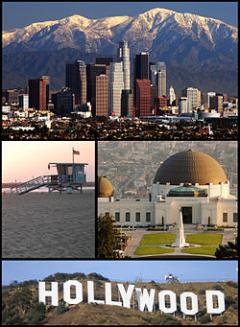
Los Angeles ( i/lÉas ËnR¦ndÊaÉolÉos/ loss-AN-jÉo-lÉos; Spanish: [los ËnaÅoxeles], which is written Los Rangeles, Spanish for The Angels), often known by its initials L.A., is the most populous city in the U.S. state of California and the second most populous in the United States, after New York City, with a population at the 2010 United States Census of 3,792,621. It has an area of 469 square miles (1,215 km2), and is located in Southern California. The city is the focal point of the larger Los Angeles aeLong Beach aeSanta Ana metropolitan statistical area and Greater Los Angeles Area region, which contain 12,828,837 and nearly 18 million people respectively as of 2010, making it one of the most populous metropolitan areas in the world and the second largest in the United States. Los Angeles is also the seat of Los Angeles County, the most populated and one of the most ethnically diverse counties in the United States, while the entire Los Angeles area itself has been recognized as the most diverse of the nation's largest cities. The city's inhabitants are referred to as "Angelenos."
i/lÉas ËnR¦ndÊaÉolÉos/ loss-AN-jÉo-lÉos; Spanish: [los ËnaÅoxeles], which is written Los Rangeles, Spanish for The Angels), often known by its initials L.A., is the most populous city in the U.S. state of California and the second most populous in the United States, after New York City, with a population at the 2010 United States Census of 3,792,621. It has an area of 469 square miles (1,215 km2), and is located in Southern California. The city is the focal point of the larger Los Angeles aeLong Beach aeSanta Ana metropolitan statistical area and Greater Los Angeles Area region, which contain 12,828,837 and nearly 18 million people respectively as of 2010, making it one of the most populous metropolitan areas in the world and the second largest in the United States. Los Angeles is also the seat of Los Angeles County, the most populated and one of the most ethnically diverse counties in the United States, while the entire Los Angeles area itself has been recognized as the most diverse of the nation's largest cities. The city's inhabitants are referred to as "Angelenos."
Los Angeles was founded on September 4, 1781, by Spanish governor Felipe de Neve. It became a part of Mexico in 1821 following the Mexican War of Independence. In 1848, at the end of the Mexican aeAmerican War, Los Angeles and the rest of California were purchased as part of the Treaty of Guadalupe Hidalgo, thereby becoming part of the United States. Los Angeles was incorporated as a municipality on April 4, 1850, five months before California achieved statehood.
Nicknamed the City of Angels, Los Angeles is a leading world center of business, international trade, entertainment, culture, media, fashion, science, sports, technology, and education, and has been ranked the third richest city and fifth most powerful and influential city in the world. The city is home to renowned institutions covering a broad range of professional and cultural fields and is one of the most substantial economic engines within the United States. The Los Angeles combined statistical area (CSA) has a gross metropolitan product (GMP) of $831 billion (as of 2008), making it the third largest economic center in the world, after the Greater Tokyo and New York metropolitan areas. As the home base of Hollywood, it is also known as the "Entertainment Capital of the World," leading the world in the creation of motion pictures, television productions, stage productions, video games, and recorded music. The importance of the entertainment business to the city has led many celebrities to call Los Angeles and its surrounding suburbs home. Additionally, Los Angeles hosted the Summer Olympic Games in 1932 and 1984.
 Spanish Empire 1781 ae1821
Spanish Empire 1781 ae1821

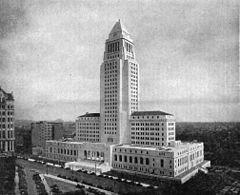
The Los Angeles coastal area was first settled by the Tongva (or GabrieleR±os) and Chumash Native American tribes thousands of years ago. Juan RodrRguez Cabrillo, a Portuguese-born explorer, claimed the area of southern California for the Spanish Empire in 1542. Gaspar de PortolRr and Franciscan missionary Juan CrespR, reached the present site of Los Angeles on August 2, 1769.
In 1771, Franciscan friar JunRpero Serra directed the building of the Mission San Gabriel Arcangel, the first mission in the area. On September 4, 1781, a group of forty-four settlers known as "Los Pobladores" founded the pueblo called "La Reyna de los Angeles", named for Nuestra SeR±ora la Reina de los Rangeles del RRo de PorciRºncula (Our Lady the Queen of the Angels of the PorciRºncula River). Two-thirds of the settlers were mestizo or mulatto with African, Amerindian, and European ancestry. The settlement remained a small ranch town for decades, but by 1820 the population had increased to about 650 residents. Today, the pueblo is commemorated in the historic district of Los Angeles Pueblo Plaza and Olvera Street, the oldest part of Los Angeles.
New Spain achieved its independence from the Spanish Empire in 1821, and the pueblo continued as a part of Mexico. During Mexican rule, Governor PRo Pico made Los Angeles Alta California's regional capital. Mexican rule ended during the Mexican aeAmerican War: Americans took control from the Californios after a series of battles, culminating with the signing of the Treaty of Cahuenga on January 13, 1847.
Railroads arrived with the completion of the Southern Pacific line to Los Angeles in 1876. Oil was discovered in 1892, and by 1923, the discoveries had helped California become the country's largest oil producer, accounting for about one-quarter of the world's petroleum output.
By 1900, the population had grown to more than 102,000, putting pressure on the city's water supply. The completion of the Los Angeles Aqueduct in 1913, under the supervision of William Mulholland, assured the continued growth of the city.
In 1910, not only had the city of Los Angeles annexed Hollywood, but there were already at least 10 movie companies operating in the city. By 1921, more than 80 percent of the world's film industry was concentrated in L.A. The money generated by the industry kept the city insulated from much of the economic pain suffered by the rest of the country during the Great Depression. By 1930, the population surpassed one million. In 1932, the city hosted the Summer Olympics.
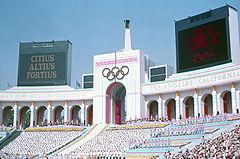
Following the end of World War II, Los Angeles grew more rapidly than ever, sprawling into the San Fernando Valley. In 1969, Los Angeles became one of the birthplaces of the Internet, as the first ARPANET transmission was sent from the University of California, Los Angeles (UCLA) to SRI in Menlo Park.
In 1984, the city hosted the Summer Olympic Games for the second time. Despite being boycotted by 14 Communist countries, the 1984 Olympics became more financially successful than any previous, and the second Olympics to turn a profit until then ae the other, according to an analysis of contemporary newspaper reports, being the 1932 Summer Olympics, also held in Los Angeles.
Racial tensions erupted on April 29, 1992, with the acquittal by a Simi Valley jury of the police officers captured on videotape beating Rodney King, culminating in large-scale riots. In 1994, the 6.7 Northridge earthquake shook the city, causing $12.5 billion in damage and 72 deaths. The century ended with the Rampart scandal, one of the most extensive documented cases of police misconduct in American history.
In 2002, voters defeated efforts by the San Fernando Valley and Hollywood to secede from the city.
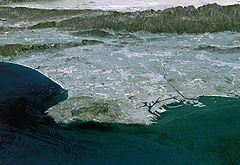
Los Angeles is irregularly shaped and covers a total area of 502.7 square miles (1,302 km2), comprising 468.7 square miles (1,214 km2) of land and 34.0 square miles (88 km2) of water. The city extends for 44 miles (71 km) longitudinally and for 29 miles (47 km) latitudinally. The perimeter of the city is 342 miles (550 km).
Los Angeles is both flat and hilly. The highest point in the city is 5,074 ft (1,547 m) Mount Lukens, located at the northeastern end of the San Fernando Valley. The eastern end of the Santa Monica Mountains stretches from Downtown to the Pacific Ocean and separates the Los Angeles Basin from the San Fernando Valley. Other hilly parts of Los Angeles include the Mt. Washington area north of Downtown, eastern parts such as Boyle Heights, the Crenshaw district around the Baldwin Hills, and the San Pedro district.
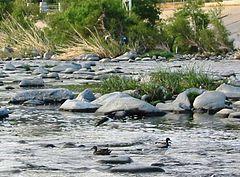
The Los Angeles River, which is largely seasonal, is the primary drainage channel. It was straightened and lined in 51 miles of concrete by the Army Corps of Engineers to act as a flood control channel. The river begins in the Canoga Park district of the city, flows east from the San Fernando Valley along the north edge of the Santa Monica Mountains, and turns south through the city center, flowing to its mouth in the Port of Long Beach at the Pacific Ocean. The smaller Ballona Creek flows into the Santa Monica Bay at Playa del Rey.
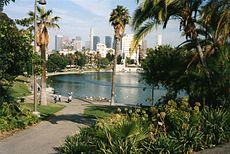
The Los Angeles area is rich in native plant species due in part to a diversity in habitats, including beaches, wetlands, and mountains. The most prevalent botanical environment is coastal sage scrub, which covers the hillsides in combustible chaparral. Native plants include: California poppy, matilija poppy, toyon, Coast Live Oak, and Giant Wildrye. Many of these native species, such as the Los Angeles sunflower, have become so rare as to be considered endangered. Though it is not native to the area, the official tree of Los Angeles is the Coral Tree (Erythrina caffra) and the official flower of Los Angeles is the Bird of Paradise (Strelitzia reginae). Mexican Fan Palms, Canary Island Palms, and California Fan Palms are common in the Los Angeles area, although only the last is native.
Los Angeles is subject to earthquakes due to its location on the Pacific Ring of Fire. The geologic instability has produced numerous faults, which cause approximately 10,000 earthquakes annually. One of the major faults is the San Andreas Fault. Located at the boundary between the Pacific Plate and the North American Plate, it is predicted to be the source of Southern California's next big earthquake. Major earthquakes to have hit the Los Angeles area include the 1994 Northridge earthquake, the 1987 Whittier Narrows earthquake, the 1971 San Fernando earthquake near Sylmar, and the 1933 Long Beach earthquake. Nevertheless, all but a few quakes are of low intensity and are not felt. The Los Angeles basin and metropolitan area are also at risk from blind thrust earthquakes. Parts of the city are also vulnerable to tsunamis; harbor areas were damaged by waves from the Valdivia earthquake in 1960.
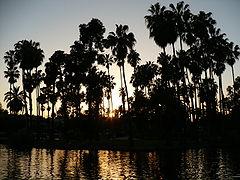
Los Angeles has a Subtropical-Mediterranean climate (Koppen climate classification Csb on the coast, Csa inland), and receives just enough annual precipitation to avoid Koppen's BSh (semi-arid climate) classification. Los Angeles has plenty of sunshine throughout the year, with an average of only 35 days with measurable precipitation annually.
The average annual temperature in downtown is 66 °F (19 °C): 75 °F (24 °C) during the day and 57 °F (14 °C) at night. In the coldest month, January, the temperature typically ranges from 59 to 73 °F (15 to 23 °C) during the day and 45 to 55 °F (7 to 13 °C) at night. In the warmest month ae August ae the temperature typically ranges from 79 to 90 °F (26 to 32 °C) during the day and around 64 °F (18 °C) at night. Temperatures exceed 90 °F (32 °C) on a dozen or so days in the year, from one day a month in April, May, June and November to three days a month in July, August, October and to five days in September. Temperatures are subject to substantial daily swings; in inland areas the difference between the average daily low and the average daily high is over 30 °F (17 °C). The average annual temperature of the sea is 63 °F (17 °C), from 58 °F (14 °C) in January to 68 °F (20 °C) in August. Hours of sunshine total more than 3,000 per year, from an average of 7 hours of sunshine per day in December to an average of 12 in July.
The Los Angeles area is also subject to phenomena typical of a microclimate, causing extreme variations in temperature in close physical proximity to each other. For instance, the average July maximum temperature at the Santa Monica Pier is 75 °F (24 °C) whereas it is 95 °F (35 °C) in Canoga Park. The city, like much of the southern California coast, is subject to a late spring/early summer weather phenomenon called "June Gloom." This involves overcast or foggy skies in the morning which yield to sun by early afternoon.
Downtown Los Angeles averages 15.14 inches (384.6 mm) of precipitation annually, which mainly occurs during the winter and spring (November through April), generally in the form of moderate rain showers, but often as heavy rainfall and thunderstorms during winter storms. The coast gets slightly less rainfall, while the mountains get slightly more. However the San Fernando Valley Region of Los Angeles can get between 16 and 20 inches (410 and 510 mm) of rain per year. Years of average rainfall are rare; the usual pattern is bimodal, with a short string of dry years (perhaps 7 ae8 inches/180 ae200 millimetres) followed by one or two wet years that make up the average. Snowfall is extremely rare in the city basin, but the mountains within city limits typically receive snowfall every winter. The greatest snowfall recorded in downtown Los Angeles was 2 inches (5 cm) in 1932. The highest recorded temperature in downtown Los Angeles is 113 °F (45 °C) on September 27, 2010 and the lowest recorded temperature is 24 °F ( na4 °C) on December 22, 1944.

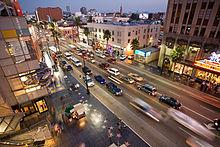
The city is divided into over 80 districts and neighborhoods, many of which were incorporated places or communities that were annexed by the city. Greater Los Angeles includes a number of enclaves and nearby communities. Generally, the city is divided into the following areas: Downtown Los Angeles, East Los Angeles and Northeast Los Angeles, South Los Angeles, the Harbor Area, Greater Hollywood, Wilshire, the Westside, and the San Fernando and Crescenta Valleys.
Some well-known communities within Los Angeles include West Adams, Watts, Leimert Park, Baldwin Hills, Venice, the Downtown Financial District, Silver Lake, Hollywood, Koreatown, Westwood and the more affluent areas of Bel Air, Benedict Canyon, Hollywood Hills, Los Feliz, Hancock Park, Pacific Palisades, Century City, and Brentwood.
Important landmarks in Los Angeles include Walt Disney Concert Hall, the Cathedral of Our Lady of the Angels, Angels Flight, the Kodak Theatre, the Griffith Observatory, the Getty Center, the Getty Villa, the Los Angeles Memorial Coliseum, the Los Angeles County Museum of Art, Grauman's Chinese Theatre, the Hollywood Sign, the Bradbury Building, Hollywood Boulevard, the Capitol Records Building, Los Angeles City Hall, the Hollywood Bowl, the Theme Building, the Watts Towers, the Staples Center, Dodger Stadium, and La Placita Olvera/Olvera Street.

L.A. Live

Grauman's Chinese Theatre

Griffith Observatory

Capitol Records Building

Angels Flight
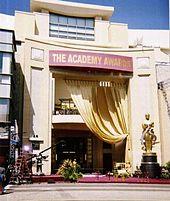
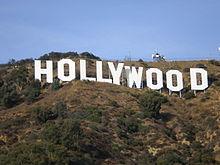
Los Angeles is often billed as the "Creative Capital of the World", due to the fact that one in every six of its residents works in a creative industry. According to the USC Stevens Institute for Innovation, "there are more artists, writers, filmmakers, actors, dancers and musicians living and working in Los Angeles than any other city at any time in the history of civilization."
Los Angeles is home to Hollywood, globally recognized as the epicenter of the motion picture industry. A testament to its preeminence in film, the city plays host to the annual Academy Awards, the oldest and one of the most prominent award ceremonies in the world. Finally, Los Angeles is home to the USC School of Cinematic Arts, the oldest film school in the United States.
The performing arts play a major role in Los Angeles' cultural identity. According to the USC Stevens Institute for Innovation, "there are more than 1,100 annual theatrical productions and 21 openings every week." The Los Angeles Music Center is "one of the three largest performing arts centers in the nation," with more than 1.3 million visitors per year. The Walt Disney Concert Hall, centerpiece of the Music Center, is home to the prestigious Los Angeles Philharmonic. Notable organizations such as Center Theatre Group, the Los Angeles Master Chorale, and the Los Angeles Opera are also resident companies of the Music Center. Talent is locally cultivated at premier institutions such as the Colburn School and the USC Thornton School of Music.
There are 841 museums and art galleries in Los Angeles County. In fact, Los Angeles has more museums per capita than any other city in the world. Some of the notable museums are the Los Angeles County Museum of Art (the largest art museum in the Western United States), the Getty Center (part of the larger J. Paul Getty Trust, the world's wealthiest art institution), and the Museum of Contemporary Art. A significant number of art galleries are located on Gallery Row, and tens of thousands attend the monthly Downtown Art Walk there.
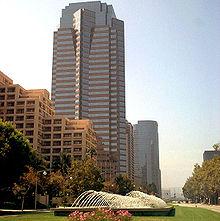
The major daily English-language newspaper in the area is the Los Angeles Times. La OpiniR³n is the city's major daily Spanish-language paper, The Korea Times is the city's major daily Korean language paper, and The Los Angeles Sentinel is the city's major African-American daily paper, boasting the largest Black readership in the Western United States. Investor's Business Daily is distributed from its L.A. corporate offices, which are headquartered in Playa Del Rey. There are also a number of smaller regional newspapers, alternative weeklies and magazines, including the Daily News (which focuses coverage on the San Fernando Valley), LA Weekly, Los Angeles CityBeat, L.A. Record (which focuses coverage on the music scene in the Greater Los Angeles Area), Los Angeles magazine, Los Angeles Business Journal, Los Angeles Daily Journal (legal industry paper), The Hollywood Reporter and Variety (entertainment industry papers), and Los Angeles Downtown News. In addition to the major papers, numerous local periodicals serve immigrant communities in their native languages, including Armenian, English, Korean, Persian, Russian, Chinese, Japanese, Hebrew, and Arabic. Many cities adjacent to Los Angeles also have their own daily newspapers whose coverage and availability overlaps into certain Los Angeles neighborhoods. Examples include The Daily Breeze (serving the South Bay), and The Long Beach Press-Telegram.
Los Angeles and New York City are the only two media markets to have seven VHF allocations assigned to them.
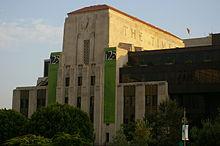
The city has major broadcast channels as well as three PBS stations. World TV operates on two channels and the area has several Spanish-language television networks. KTBN 40 is the flagship station of the religious Trinity Broadcasting Network, based out of Santa Ana. A variety of independent television stations also operate in the area.
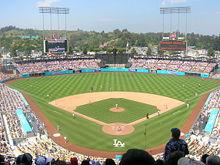
Los Angeles is the home of the Los Angeles Dodgers of Major League Baseball, the Los Angeles Kings of the National Hockey League, the Los Angeles Clippers and Los Angeles Lakers of the National Basketball Association, the Los Angeles D-Fenders, an NBA Development team owned by the Los Angeles Lakers, and the Los Angeles Sparks of the Women's National Basketball Association. Los Angeles is also home to the USC Trojans and the UCLA Bruins in the NCAA, both of which are Division I teams in the Pacific-12 Conference. The Los Angeles Galaxy and Club Deportivo Chivas USA of Major League Soccer are based in Carson.
Los Angeles is the second-largest city and television market in the United States, but has no NFL team; the nearest team is located in San Diego and are called the Chargers. At one time Los Angeles area had two NFL teams, the Rams and the Raiders. Both left the city in 1995, with the Rams moving to St. Louis and the Raiders heading back to their original home of Oakland. Prior to 1995, the Rams called Memorial Coliseum home (1946 ae1979) and the Raiders played their home games at Memorial Coliseum from 1982 to 1994.
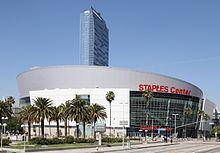
Since the franchise's departures the NFL as an organization, and individual NFL owners, have attempted to relocate a team to the city. Immediately following the 1995 NFL season, Seattle Seahawks owner Ken Behring went as far as packing up moving vans to start play in the Rose Bowl under a new team name and logo for the 1996 season. The State of Washington filed a lawsuit to prevent the move. In 2003, then-NFL Commissioner Paul Tagliabue said that he thought that Los Angeles would get a new expansion team, a thirty-third franchise, after the choice of Houston over Los Angeles in the 2002 league expansion round. Despite these efforts, and the failure to build a new stadium for an NFL team, Los Angeles is still expected to return to the league through expansion or relocation. On August 9, 2011 the LA City Council approved plans to build Farmers Field, which will become home to an NFL team in the future. The stadium is expected to be completed by 2016.
Los Angeles has twice played host to the Summer Olympic Games, in 1932 and in 1984. When the tenth Olympic Games were hosted in 1932, the former 10th Street was renamed Olympic Blvd. Super Bowls I and VII were also held in the city as well as multiple FIFA World Cup games in 1994 including the final. Los Angeles will host the Special Olympics World Summer Games in 2015.
Los Angeles also boasts a number of sports venues, including Dodger Stadium, Los Angeles Coliseum, The Forum, Staples Center, a sports and entertainment complex that also hosts concerts and awards shows such as the Grammys. Staples Center also serves as the home arena for the Los Angeles Clippers and Los Angeles Lakers of the NBA, the Los Angeles Sparks of the WNBA, and the Los Angeles Kings of the NHL. It was also home to the Los Angeles Avengers of the original AFL, a team that did not participate in that league's ongoing revival.
The Los Angeles Angels of Anaheim of Major League Baseball and the Anaheim Ducks of the National Hockey League are in the Los Angeles media market and are based in Anaheim in Orange County. The Angels began as an expansion franchise team in Los Angeles in 1961 and played at Los Angeles' Wrigley Field and then Dodger Stadium before moving to Anaheim in 1966. The Ducks, who have played in Anaheim since their inception as an expansion team in 1993, were originally owned by Disney and known as the Mighty Ducks of Anaheim, after the popular Disney film. The team adopted its current name in 2006, a year after Disney sold the franchise.
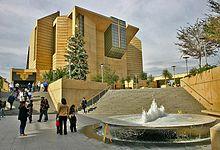
The Roman Catholic Archbishop of Los Angeles leads the largest archdiocese in the country. Cardinal Roger Mahony oversaw construction of the Cathedral of Our Lady of the Angels, which opened in September, 2002 in downtown Los Angeles. Construction of the cathedral marked a coming of age of the city's Catholic, heavily Latino community. There are numerous Catholic churches and parishes throughout Los Angeles.
With 621,000 Jews in the metropolitan area (490,000 in city proper), the region has the second largest population of Jews in the United States. Many of Los Angeles' Jews now live on the Westside and in the San Fernando Valley, though Boyle Heights and Northwest Los Angeles once had large Jewish populations. Many varieties of Judaism are represented in the area, including Reform, Conservative, Orthodox, and Reconstructionist. The Breed Street Shul in East Los Angeles, built in 1923, was the largest synagogue west of Chicago in its early decades. (It is no longer a sacred space and is being converted to a museum and community center.) The Kabbalah Centre also has a presence in the city.
Los Angeles has had a rich and influential Protestant tradition. The first Protestant service in Los Angeles was a Methodist meeting held in a private home in 1850 and the oldest Protestant church still operating was founded in 1867. In the early 1900s the Bible Institute Of Los Angeles published the founding documents of the Christian Fundamentalist movement and the Azusa Street Revival launched Pentecostalism. Aimee Semple McPherson broadcast over the radio in the 1920s from the Angelus Temple, home of the International Church of the Foursquare Gospel and its Life Pacific College. The Potter's House Christian Fellowship and Metropolitan Community Church also had their origins in the city. Billy Graham's first big success came in L.A. (in 1949) and notable ministers connected to the city include Robert P. Shuler, Charles E. Fuller, Gene Scott, Jesse Lee Peterson, and Solomon Burke. Important churches in the city include First Presbyterian Church of Hollywood, Bel Air Presbyterian Church, First African Methodist Episcopal Church of Los Angeles, West Angeles Church of God in Christ, Second Baptist Church, Crenshaw Christian Center, McCarty Memorial Christian Church, and First Congregational Church.
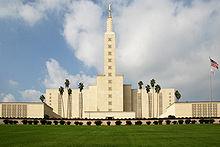
The Los Angeles California Temple, the second largest temple operated by The Church of Jesus Christ of Latter-day Saints, is on Santa Monica Boulevard in the Westwood district of Los Angeles. Dedicated in 1956, it was the first Mormon temple built in California and it was the largest in the world when completed.
The Hollywood region of Los Angeles also has several significant headquarters, churches, and the Celebrity Center of Scientology.
Because of Los Angeles' large multi-ethnic population, a wide variety of faiths are practiced, including Islam, Buddhism, Hinduism, Zoroastrianism, Sikhism, BahR¡'R, various Eastern Orthodox Churches, Sufism and others. Immigrants from Asia for example, have formed a number of significant Buddhist congregations making the city home to the greatest variety of Buddhists in the world.
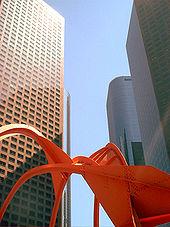
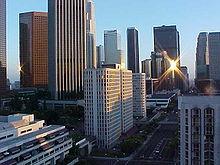
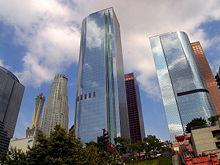
The economy of Los Angeles is driven by international trade, entertainment (television, motion pictures, video games, recorded music), aerospace, technology, petroleum, fashion, apparel, and tourism. Los Angeles is also the largest manufacturing center in the western United States. The contiguous ports of Los Angeles and Long Beach together comprise the fifth-busiest port in the world and the most significant port in the Western Hemisphere and is vital to trade within the Pacific Rim. Other significant industries include media production, finance, telecommunications, law, healthcare, and transportation. The Los Angeles aeLong Beach aeSanta Ana metropolitan statistical area (MSA) has a gross metropolitan product (GMP) of $735.7 billion (as of 2010), making it the third largest economic center in the world, after the Greater Tokyo Area and the New York-Newark-Bridgeport CSA. If counted as a country, the surrounding CSA has the 15th largest economy in the world in terms of nominal GDP. Los Angeles has been classified an "Alpha world city" according to a 2010 study by a research group at Loughborough University in England.
The city is home to seven Fortune 500 companies. They are aerospace contractor Northrop Grumman, energy company Occidental Petroleum, healthcare provider Health Net, metals distributor Reliance Steel & Aluminum, engineering firm AECOM, real estate group CBRE Group and builder Tutor Perini.
Other companies headquartered in Los Angeles include California Pizza Kitchen, Capital Group, Capstone Turbine, The Cheesecake Factory, Cathay Bank, City National Bank, The Coffee Bean & Tea Leaf, DeviantArt, Far East National Bank, Farmers Insurance Group, Fox Entertainment Group, Gibson, Dunn & Crutcher, Guess?, Hanmi Bank, Herbalife, J2 Global Communications, The Jim Henson Company, KB Home, Korn/Ferry, Latham & Watkins, Mercury Insurance Group, Oaktree Capital Management, O aoMelveny & Myers, Pabst Brewing Company, Paul, Hastings, Janofsky & Walker, Premier America, Premiere Radio Networks, Rentech, Sunkist, The TCW Group, Tokyopop, Triton Media Group, United Online, and VCA Antech.
The metropolitan area is home to the headquarters of many companies who moved outside of the city of Los Angeles to escape its high taxes and high crime rate while keeping the benefits of remaining in close proximity. For example, Los Angeles charges a gross receipts tax based on a percentage of business revenue, while many neighboring cities charge only small flat fees.
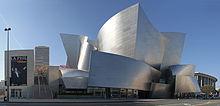
The University of Southern California (USC) is the city's largest private sector employer and contributes $4 billion annually to the local economy.
According to the city's 2010 Comprehensive Annual Financial Report, the top ten employers in the city as of 2009 are, in descending order, the City of Los Angeles, the County of Los Angeles, University of California, Los Angeles, University of Southern California, Cedars-Sinai Medical Center, Kaiser Permanente, Fox Entertainment Group, Farmers Insurance Group, TeamOne,and Northrop Grumman.
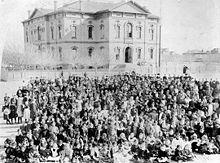
There are three public universities located within the city limits: California State University, Los Angeles (CSULA), California State University, Northridge (CSUN) and University of California, Los Angeles (UCLA). Private colleges in the city include the American Film Institute Conservatory, Alliant International University, Syracuse University (Los Angeles Campus), American InterContinental University, American Jewish University, The American Musical and Dramatic Academy ae Los Angeles campus, Antioch University's Los Angeles campus, Charles R. Drew University of Medicine and Science, Fashion Institute of Design & Merchandising's Los Angeles campus (FIDM), Los Angeles Film School, Loyola Marymount University (LMU is also the parent university of Loyola Law School located in Los Angeles), Marymount College, Mount St. Mary's College, National University of California, Occidental College ("Oxy"), Otis College of Art and Design (Otis), Southern California Institute of Architecture (SCI-Arc), Southwestern Law School, and University of Southern California (USC).
The community college system consists of nine campuses governed by the trustees of the Los Angeles Community College District: East Los Angeles College (ELAC), Los Angeles City College (LACC), Los Angeles Harbor College, Los Angeles Mission College, Los Angeles Pierce College, Los Angeles Valley College (LAVC), Los Angeles Southwest College, Los Angeles Trade-Technical College and West Los Angeles College.
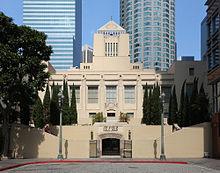
Los Angeles Unified School District serves almost all of the city of Los Angeles, as well as several surrounding communities, with a student population around 800,000. After Proposition 13 was approved in 1978, urban school districts had considerable trouble with funding. LAUSD has become known for its underfunded, overcrowded and poorly maintained campuses, although its 162 Magnet schools help compete with local private schools. Several small sections of Los Angeles are in the Las Virgenes Unified School District. The Los Angeles County Office of Education operates the Los Angeles County High School for the Arts. The Los Angeles Public Library system operates 72 public libraries in the city. Enclaves of unincorporated areas are served by the County of Los Angeles Public Library, many are within walking distance to city of Los Angeles residents.
The city and the rest of the Los Angeles metropolitan area are served by an extensive network of freeways and highways. The Texas Transportation Institute, which publishes an annual Urban Mobility Report, ranked Los Angeles road traffic as the most congested in the United States in 2005 as measured by annual delay per traveler. The average traveler in Los Angeles experienced 72 hours of traffic delay per year according to the study. Los Angeles was followed by San Francisco/Oakland, Washington, D.C. and Atlanta, (each with 60 hours of delay). Despite the congestion in the city, the mean travel time for commuters in Los Angeles is shorter than other major cities, including New York City, Philadelphia and Chicago. Los Angeles' mean travel time for work commutes in 2006 was 29.2 minutes, similar to those of San Francisco and Washington, D.C.
Among the major highways that connect LA to the rest of the nation include Interstate 5, which runs south through San Diego to Tijuana in Mexico and north through Sacramento, Portland, and Seattle to the Canadian border; Interstate 10, the southernmost east aewest, coast-to-coast Interstate Highway in the United States, going to Jacksonville, Florida; and U.S. Route 101, which heads to the California Central Coast, San Francisco, the Redwood Empire, and the Oregon and Washington coasts.
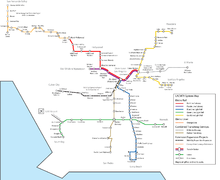
The Los Angeles County Metropolitan Transportation Authority and other agencies operate an extensive system of bus lines, as well as subway and light rail lines across Los Angeles County, with a combined monthly ridership (measured in individual boardings) of 38.8 million as of September, 2011. The majority of this (30.5 million) is taken up by the city's bus system,[100] the second busiest in the country. The subway and light rail combined average the remaining roughly 8.2 million boardings per month.[100] In 2005, 10.2% of Los Angeles commuters rode some form of public transportation.[101]
The city's subway system is the ninth busiest in the United States and its light rail system is the country's second busiest.[102] The rail system includes the Red and Purple subway lines, as well as the Gold, Blue, Expo, and Green light rail lines. The Metro Orange and Silver lines are bus rapid transit lines with stops and frequency similar to those of light rail. The city is also central to the commuter rail system Metrolink, which links Los Angeles to all neighboring counties as well as many suburbs.
Besides the rail service provided by Metrolink and the Los Angeles County Metropolitan Transportation Authority, Los Angeles is served by inter-city passenger trains from Amtrak. The main rail station in the city is Union Station just north of Downtown.
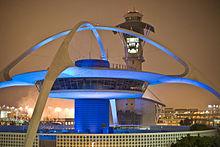
The main Los Angeles airport is Los Angeles International Airport (IATA: LAX, ICAO: KLAX). The sixth busiest commercial airport in the world and the third busiest in the United States, LAX handled over 61 million passengers and 2 million tons of cargo in 2006. LAX is a hub for United Airlines[103]
Other major nearby commercial airports include:
One of the world's busiest general-aviation airports is also located in Los Angeles, Van Nuys Airport (IATA: VNY, ICAO: KVNY).[104]
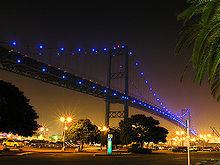
The Port of Los Angeles is located in San Pedro Bay in the San Pedro neighborhood, approximately 20 miles (32 km) south of Downtown. Also called Los Angeles Harbor and WORLDPORT LA, the port complex occupies 7,500 acres (30 km2) of land and water along 43 miles (69 km) of waterfront. It adjoins the separate Port of Long Beach.
The sea ports of the Port of Los Angeles and Port of Long Beach together make up the Los Angeles/Long Beach Harbor.[105][106][107] Together, both ports are the fifth busiest container port in the world, with a trade volume of over 14.2 million TEU's in 2008.[108] Singly, the Port of Los Angeles is the busiest container port in the United States and the largest cruise ship center on the West Coast of the United States ae The Port of Los Angeles' World Cruise Center served about 800,000 passengers in 2009.[109]
There are also smaller, non-industrial harbors along Los Angeles' coastline.
The port includes four bridges: the Vincent Thomas Bridge, Henry Ford Bridge, Gerald Desmond Bridge, and Commodore Schuyler F. Heim Bridge.
Passenger ferry service from San Pedro to the city of Avalon on Santa Catalina Island is provided by Catalina Express.
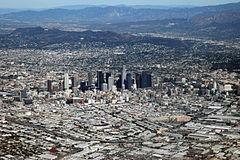

The 2010 United States Census[112] reported that Los Angeles had a population of 3,792,621.[113] The population density was 7,544.6 people per square mile (2,913.0/km ²). The Census reported that 3,708,020 people (97.8% of the population) lived in households, 58,186 (1.5%) lived in non-institutionalized group quarters, and 26,415 (0.7%) were institutionalized.
The age distribution was 874,525 people (23.1%) under 18, 434,478 people (11.5%) from 18 to 24, 1,209,367 people (31.9%) from 25 to 44, 877,555 people (23.1%) from 45 to 64, and 396,696 people (10.5%) who were 65 or older.[113] The median age was 34.1 years. For every 100 females there were 99.2 males. For every 100 females age 18 and over, there were 97.6 males.[113]
There were 1,413,995 housing units aeup from 1,298,350 during 2005 ae2009[113] aeat an average density of 2,812.8 households per square mile (1,086.0/km ²), of which 503,863 (38.2%) were owner-occupied, and 814,305 (61.8%) were occupied by renters. The homeowner vacancy rate was 2.1%; the rental vacancy rate was 6.1%. 1,535,444 people (40.5% of the population) lived in owner-occupied housing units and 2,172,576 people (57.3%) lived in rental housing units.
Los Angeles is home to people from more than 140 countries speaking 224 different identified languages.[114] Ethnic enclaves like Chinatown, Historic Filipinotown, Koreatown, Little Armenia, Little Ethiopia, Tehrangeles, Little Tokyo, and Thai Town provide examples of the polyglot character of Los Angeles.
According to the 2010 Census, the racial makeup of Los Angeles included: 1,888,158 Whites (49.8%), 365,118 African Americans (9.6%), 28,215 Native Americans (0.7%), 426,959 Asians (11.3%), 5,577 Pacific Islanders (0.1%), 902,959 from other races (23.8%), and 175,635 (4.6%) from two or more races.[113] Hispanics or Latinos of any race were 1,838,822 persons (48.5%).
Non-Hispanic whites were 28.7% of the population in 2010,[113] compared to 86.3% in 1940.[115] Mexicans make up the largest ethnic group of Latinos at 31.9% of Los Angeles' population, followed by Salvadorans (6.0%) and Guatemalans (3.6%). The Latino population is spread throughout the city of Los Angeles and its metropolitan area but it is most heavily concentrated in the East Los Angeles region, which has a long established Mexican American and Central American community.
The largest Asian ethnic groups are Filipinos (3.2%) and Koreans (2.9%), which have their own established ethnic enclaves naKoreatown in the Wilshire Center and the Historic Filipinotown. Chinese people, which make up 1.8% of Los Angeles' population, reside mostly outside of Los Angeles city limits and rather in the San Gabriel Valley of eastern Los Angeles County, but make a sizable presence in the city, notably in Chinatown. Chinatown and Thaitown are also home to many Thais and Cambodians, which make up 0.3% and 0.1% of Los Angeles' population, respectively. Japanese comprise 0.9% of L.A.'s population, and have an established Little Tokyo in the city's downtown, and another significant community of Japanese Americans is located in the Sawtelle district of West Los Angeles. Vietnamese make up 0.5% of Los Angeles' population. L.A. has a rather small South Asian population naIndians make up 0.9% of the city's population.
The city of Los Angeles and its metropolitan area are home to a large Middle Eastern population, including Armenians and Iranians, partially residing in enclaves like Little Armenia and Tehrangeles.
African Americans have the largest establishment in South Los Angeles, remarkably within the industrial neighborhoods of Crenshaw and Watts.[116] However, since the 1980s, there has been a large influx of immigration from Mexico and Central America which have outnumbered the blacks in South Los Angeles. South Los Angeles, as well as neighboring communities such as the city of Compton that were home to predominant African American populations are now transforming into Hispanic communities.[117]
Pacific Islanders make up a scant 0.1% of Los Angeles' population, but are prevalent in southwestern Los Angeles County, namely in Long Beach and Carson, which are home to thousands of Samoan Americans.[118]
The city is governed by a mayor-council system. The current mayor is Antonio Villaraigosa. There are 15 city council districts. Other elected city officials include the City Attorney Carmen Trutanich and the City Controller Wendy Greuel. The city attorney prosecutes misdemeanors within the city limits. The district attorney, elected by county voters, prosecutes misdemeanors in unincorporated areas and in 78 of the 88 cities in the county, as well as felonies throughout the county.
The Los Angeles Police Department (LAPD) polices the city of Los Angeles, but the city also maintains four specialized police agencies; The Office of Public Safety, within the General Services Department (which is responsible for security and law enforcement services at city facilities, including City Hall, city parks and libraries, the Los Angeles Zoo, and the Convention Center), the Port Police, within the Harbor Department (which is responsible for land, air and sea law enforcement services at the Port of Los Angeles), the Los Angeles City Schools Police department which handles law enforcement for all city schools, and the Airport Police, within the Los Angeles World Airports Department (which is responsible for law enforcement services at all four city-owned airports, including Los Angeles International Airport (LAX), LA/Ontario International Airport (ONT), LA/Palmdale Regional Airport (PMD), and Van Nuys Airport (VNY).
The name given by the Chumash tribe of Native Americans for the area now known as Los Angeles translates to "the valley of smoke."[119] Owing to geography, heavy reliance on automobiles, and the Los Angeles/Long Beach port complex, Los Angeles suffers from air pollution in the form of smog. The Los Angeles Basin and the San Fernando Valley are susceptible to atmospheric inversion, which holds in the exhausts from road vehicles, airplanes, locomotives, shipping, manufacturing, and other sources.[120] The smog season lasts from May to October.[121] Unlike other large cities that rely on rain to clear smog, Los Angeles gets only 15 inches (380 mm) of rain each year: pollution accumulates over many consecutive days. Issues of air quality in Los Angeles and other major cities led to the passage of early national environmental legislation, including the Clean Air Act. More recently, the state of California has led the nation in working to limit pollution by mandating low-emission vehicles. Smog is expected to continue to drop in the coming years due to aggressive steps to reduce it, which include electric and hybrid cars, improvements in mass transit, and other measures.
The number of Stage 1 smog alerts in Los Angeles has declined from over 100 per year in the 1970s to almost zero in the new millennium. Despite improvement, the 2006 and 2007 annual reports of the American Lung Association ranked the city as the most polluted in the country with short-term particle pollution and year-round particle pollution.[122] In 2008, the city was ranked the second most polluted and again had the highest year-round particulate pollution.[123] The city met its goal of providing 20 percent of the city's power from renewable sources in 2010.[124]

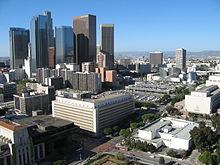
Voters created Neighborhood Councils in the Charter Reform of 1999. First proposed by City Council member Joel Wachs in 1996, they were designed to promote public participation in government and make it more responsive to local needs.
The councils cover districts that are not necessarily identical to the traditional neighborhoods of Los Angeles.
Almost ninety neighborhood councils (NCs) are certified and all "stakeholders" aemeaning anyone who lives, works or owns property in a neighborhood aemay vote for members of the councils' governing bodies. Some council bylaws allow other people with a stake in the community to cast ballots as well.
The councils are official government bodies and so their governing bodies and committees must abide by California's Brown Act, which governs the meetings of deliberative assemblies.
The first notable concern of the neighborhood councils collectively was the opposition by some of them in March 2004 to an 18% increase in water rates by the city's Department of Water and Power. This led the City Council to approve only a limited increase pending independent review. More recently, some of the councils petitioned the City Council in summer 2006 to allow them to introduce ideas for legislative action, but the City Council put off a decision.
The neighborhood councils have been allocated $45,000 each per year for administration, outreach and approved neighborhood projects.
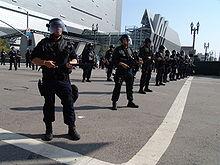
Like most American cities, Los Angeles has been experiencing significant decline in crime since the mid-1990s, and reached a 50-year low in 2009 with 314 homicides.[125][126] Antonio Villaraigosa is a member of the Mayors Against Illegal Guns Coalition.[127]
In 2009, Los Angeles reported 314 homicides, which corresponds to a rate of 7.85 (per 100,000 population) aea major decrease from 1993, when the all time homicide rate of over 21.1 (per 100,000 population) was reported for the year.[128] This included 15 officer-involved shootings. One shooting led to the death of a SWAT team member, Randal Simmons, the first in LAPD's history.[129]
The Los Angeles crime family dominated organized crime in the city during the Prohibition era[130] and reached its peak during the 1940s and 1950s as part of the American Mafia but has gradually declined since then with the rise of various black and Hispanic gangs.[131]
According to the Los Angeles Police Department, the city is home to 45,000 gang members, organized into 450 gangs.[132] Among them are the Crips and Bloods, which are both African American street gangs that originated in South Central Los Angeles. Latino street gangs such as the SureR±os, a Mexican American street gang, and the Mara Salvatrucha, which has mainly members of Central American origin, particularly those of Salvadoran descent, have all originated in Los Angeles. The 18th Street has a predominately Latino membership but is multiethnic. This has led to the city being referred to as the "Gang Capital of America".[133]
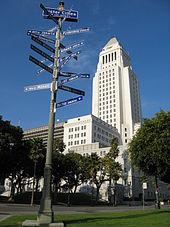
Los Angeles has 25 sister cities,[134] listed chronologically by year joined:
In addition, Los Angeles has the following "friendship cities":[135][136]



Word Count: 8039






